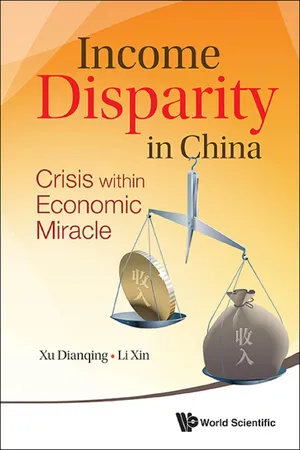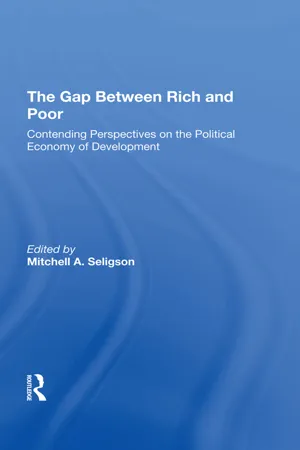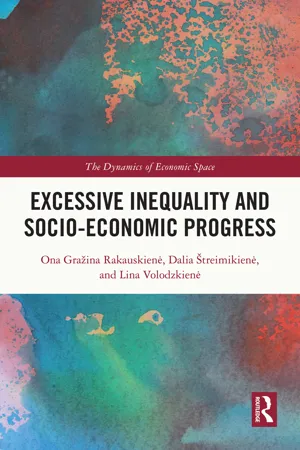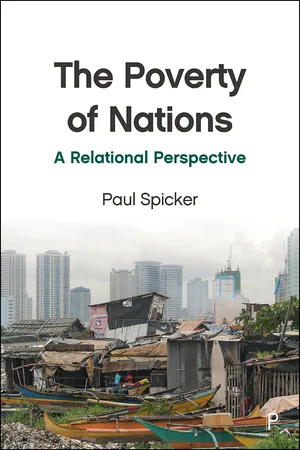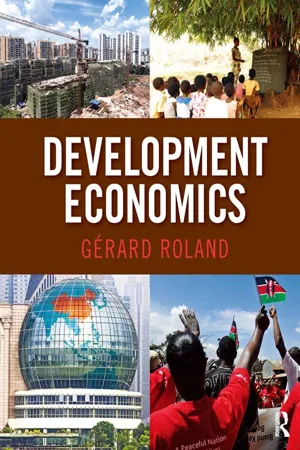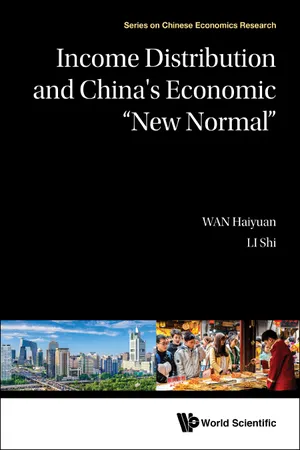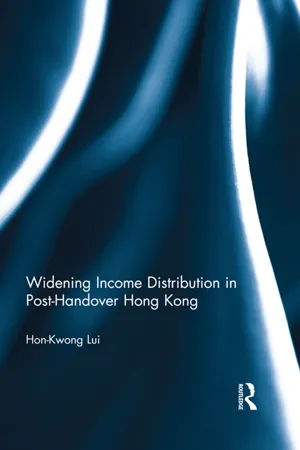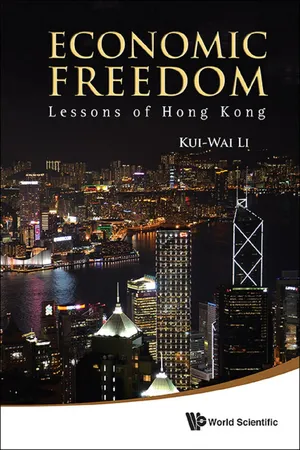Economics
The Gap between Rich and Poor
The gap between the rich and the poor refers to the disparity in income and wealth distribution within a society. It is a measure of economic inequality and can have significant social and political implications. Factors contributing to this gap include differences in education, access to resources, and economic policies. Addressing this gap is a key concern for policymakers and economists.
Written by Perlego with AI-assistance
Related key terms
Related key terms
1 of 4
Related key terms
1 of 3
10 Key excerpts on "The Gap between Rich and Poor"
- eBook - ePub
Income Disparity In China: Crisis Within Economic Miracle
Crisis within Economic Miracle
- Dianqing Xu, Xin Li(Authors)
- 2014(Publication Date)
- WSPC(Publisher)
Gini Coefficient: A Measure of the Gap between the Rich and the Poor The pairing of efficiency and equity has many contradictions. Under the planned economic system, too much emphasis on equality at the expense of efficiency leads to widespread poverty. Conversely, too much emphasis on efficiency increases the gap between the rich and the poor, which threatens social stability. Kuznets summarized the variation law on the gap between the rich and the poor in the process of economic development and proposed the well-known inverted U-shaped curve. Kuznets argues that the gap between the rich and the poor will increase in the early stages of economic development. However, the increase in per capita income will narrow the gap gradually. 4 The inverted U-shaped curve will not appear automatically. Therefore, the income gap should not be allowed to widen. Kuznets advocates the use of financial subsidies, social welfare, and other secondary means of distribution to help the poor. He also recommends implementation of the graduated tax system to target the inheritance and the capital income of the rich to bridge the gap between the rich and the poor. If the government policies fail, the gap between the rich and the poor is likely to continue to widen, subvert the social stability, and terminate the economic growth. Todaro and other economists analyzed the data of 43 developing countries and found that the benefits of economic growth would not flow automatically to the extreme poverty groups. In many countries, despite economic development, the poor’s absolute income and relative income have declined. However, exceptions exist such as the cases of Taiwan and South Korea. The Gini coefficients in China’s Taiwan region and South Korea did not increase significantly despite economic growth. 5 In other words, high economic growth does not necessarily lead to the deterioration of income distribution, and low economic growth does not mean equality of income distribution - eBook - ePub
The Gap Between Rich And Poor
Contending Perspectives On The Political Economy Of Development
- Mitchell A Seligson(Author)
- 2019(Publication Date)
- Routledge(Publisher)
The success of rebuilding Europe encouraged many to believe that similar success would meet efforts to stimulate growth in the developing world. More often than not, however, such efforts have failed or fallen far below expectations. Even when programs have been successful and nations seemed well on the way toward rapid growth, they nonetheless continued to fall further and further behind the already wealthy countries. Moreover, growth seemed to be accompanied by a widening income gap within the developing countries.The authors of this collection present a comprehensive treatment of the thinking that is evolving on the subject of the international and domestic gaps between rich and poor. Their studies are not confined to a single academic discipline or geographic area. Rather, their work reflects a variety of disciplines, including economics, political science, sociology, history, psychology, and geography, to mention the principal ones, and they have examined the problems from the viewpoint of a single country or region as well as with a macroanalytic approach. This diversity produced three major perspectives on the gap.In the first, the widening gap between rich and poor nations is viewed as being principally a cultural problem. Specifically, the cultural values associated with industrialization are seen as foreign to many developing nations, which are deeply attached to more traditional cultural values. Yet the values of punctuality, hard work, achievement, and other “industrial” values are keys to unlocking the economic potential of poor countries, according to these scholars. Most adherents of this perspective believe that such values can be inculcated in a population through deliberate effort. Others argue that the values will emerge naturally as the result of a worldwide process of diffusion of values functional for development. This perspective has been incorporated into a more general school of thought focusing on the process called “modernization.” Development occurs and the international gap is narrowed when a broad set of modern values and - eBook - ePub
- Ona Gražina Rakauskienė, Dalia Štreimikienė, Lina Volodzkienė(Authors)
- 2022(Publication Date)
- Routledge(Publisher)
Characteristics of economic inequality. Inequality is a state of disparity or imbalance, especially in terms of social status, rights, and opportunities (UN, 2015). However, the use of the latter term in various contexts is often confusing. The concept of economic inequality is defined by its extensiveness and complexity. Economic inequality can be understood as inequality affecting the economy, or inequality of economic origin, which can be both a consequence and a cause of existing economic processes (Salverda, Nolan, & Smeeding, 2013). Economic inequality is a difference that arises when measuring economic well-being between individuals, groups, societies, and countries. Economic inequality is sometimes perceived as income inequality, wealth inequality, or the wealth gap. When focusing on inequalities, economists usually consider income, consumption, and wealth (Rakauskienė et al., 2017). Research on economic inequality is related to the essence and content of equality, equality of opportunity, and equality of outcome.The concept of economic inequality combines several different approaches. First, inequality is understood as an internal element of society. According to S. Kuznets (1955), inequality did not exist only in the early history of mankind (in hunter-gatherer communities), but with the discovery of agriculture and more sedentary lifestyle, tribal leaders could enjoy a better life than the rest. Later, the pharaohs, kings, and emperors, along with other elites, also lived better than the rest of the population, and the more talented merchants or artisans lived better than the rest of the townspeople. Even in the Soviet Union, despite ideological aspirations to make everyone equal in terms of wealth, richer elite quickly formed. Therefore, economic inequality became a normal phenomenon, completely independent of the economic integration that prevailed at one time or another in human history. Thus, economic inequality has always existed whether slavery, feudal, capitalist, or socialist economies prevailed, as differences arise primarily due to objective reasons: education, skills, intelligence, physical characteristics, health status, the amount of accumulated and inherited wealth, risk, and even success.Second, economic inequality is an organic and integral part of any society - eBook - ePub
The Poverty of Nations
A Relational Perspective
- Spicker, Paul, Paul Spicker(Authors)
- 2020(Publication Date)
- Policy Press(Publisher)
PART I Poverty: economic and social relationshipsPassage contains an image 1 Poverty
Poverty is complex and multi-faceted, a constellation of issues rather than a single problem. There are more concepts of poverty than it is possible to discuss in this book, but in previous work I have argued that it is possible to see several clusters of meaning – ‘families’ of interrelated concepts.1 Some concepts of poverty relate to material conditions :• A generally low standard of living, where poverty becomes a struggle to manage in everyday life. The World Bank has described poverty as ‘the inability to attain a minimal standard of living’.2• The lack of specific goods and items, such as housing, fuel, or food. For Vic George, this depended on ‘a core of basic necessities as well as a list of other necessities that change over time and place’.3• A pattern or ‘web’ of deprivation, where people have multiple deprivations, or they may be frequently deprived, though there may be considerable fluctuations in circumstances.4Some concepts of poverty are based in economic circumstances :• A lack of resources. For Townsend, people were poor because they lacked the resources to have access to the conditions of life that other people have. ‘If they lack or are denied the incomes, or more exactly the resources, including income and assets or goods or services in kind to obtain access to these conditions of life … they are in poverty.’5• An ‘economic distance’ from the rest of the population, or a degree of inequality, which means that people are unable to buy the things that others can buy.6• Economic class – an economic status, or relationship to production and the labour market, which means that people are consistently likely to be disadvantaged or deprived. Ralph Miliband wrote: ‘The basic fact is that the poor are an integral part of the working class – its poorest and most disadvantaged stratum. … Poverty is a class thing, closely linked to a general situation of class inequality.’7 - eBook - ePub
- Gerard Roland(Author)
- 2016(Publication Date)
- Routledge(Publisher)
International measures of poverty are based on poverty lines. They are calculated as the income necessary to purchase the daily amount of calories necessary to survive, taking into account the usual eating habits of a population. The poverty headcount measures the number of people who are below the poverty line. The poverty gap is calculated by multiplying the poverty headcount by a population’s average distance below the poverty line. Internationally comparable measures of poverty are difficult to determine because the exchange rates between currencies do not accurately reflect differences in the cost of living across countries. Therefore, purchasing power parity exchange rates are preferable to market exchange rates as measures of poverty, although they, too, are not perfect because they reflect average costs of living in a given country rather than the cost of living of the poor. Poverty has tended to decline in the last decades in most regions of the world except Africa. The impressive growth performance of China, India, and Asia as a whole has lifted hundreds of millions of people out of poverty.Measurements and Comparisons of Income InequalityTwo concepts are most often used to measure inequality: the quantile ratio, which measures the ratio of income between the top quantile and the bottom quantile, and the Gini coefficient, which assumes values between zero and 1. A low Gini coefficient means a relatively equal distribution of income, while a high Gini coefficient means a highly unequal distribution of income.Economic Determinants of InequalityLow access to education is associated to high income inequality. Inequality in land ownership is also an important determinant of income inequality.Inequality, Growth, and DevelopmentThe Kuznets hypothesis states that a country may first become more unequal in income distribution as it grows out of poverty and then it will become more equal again as it becomes rich. The international evidence for the Kuznets curve is weak. Economists have put forward theories based on credit constraints and political economy considerations that indicate income inequality may be bad for economic growth. While inequality has increased over time in many countries in the last 30 years, income inequality worldwide has tended to decrease. The main reason is that as China and India, in particular, have had very strong economic growth, the incomes of billions of people have increased, thereby reducing worldwide income inequality. - eBook - ePub
Economics in Christian Perspective
Theory, Policy and Life Choices
- Victor V. Claar, Robin J. Klay(Authors)
- 2015(Publication Date)
- IVP Academic(Publisher)
10Rich Man, Poor Man, Beggar Man, Thief
Attending to the Poor or Worrying About Income Gaps?
In chapter nine, “Work and Vocation,” we discussed the fundamental reasons why markets reward some people with higher incomes than others. Good choices count, whether they are to get more education or to or put off consumption today in order to save for tomorrow. Other reasons include the luck of the draw: a rare beauty or talent; a fortunate time, location and family of birth; good health and high energy levels; few family responsibilities; a better network of connections. In this chapter we consider income and wealth gaps across individuals and among certain social/ethnic and professional groups. At what point are these gaps a moral concern? What are the measures available through government, markets and private/voluntary action to mitigate suffering and to increase opportunities for those at the short end of market rewards?Rich Man, Poor Man: When Is Poverty Scandalous?
Anyone who reads the Bible knows that the plight of poor people is a special concern of God. God commands his people to make caring for the poor a top priority. The theme is introduced in a powerful and dramatic way with the liberation of Israel from Egypt. In giving the law, God repeatedly calls the Israelites to demonstrate true gratitude by “[sharing] freely with the poor” (Deut 15:11) in their midst—especially widows, orphans and strangers who were without other support.Specifically, the law called Israel to institute certain practices to meet the immediate and longer-term needs of the poor. They were to set aside certain parts of their fields for harvesting by hungry people, tithe a portion of their grain for distribution to the poor, give jobs to the needy and cancel debts that would otherwise result in the enslavement of debtors. Furthermore, a Jubilee was ordered for every fiftieth year, during which the lands (over which the “owners” were called to be God’s stewards) would revert to the original families. This was intended to break the cycle of poverty, by restoring land to poor families who had lost their lands due to bad circumstances or bad choices. With access to land they would again be able to take care of their basic needs, without resorting to begging, borrowing or indenture. - eBook - ePub
- Nan de Graaf, Dingeman Wiertz(Authors)
- 2019(Publication Date)
- Routledge(Publisher)
7 Economic inequality Chapter overview We begin this chapter with a brief discussion of why economic inequality is problematic, followed by a review of inequality trends around the world. Whereas income inequality has increased within most countries since the 1970s, global income inequality has remained stable during most of the twentieth century and has started to decline in the last few decades. This latter trend is driven by reductions in the inequality between countries, and global poverty has dropped accordingly. However, extreme poverty remains persistent in many parts of the world, and we discuss several theories to explain why this is the case. In addition, we examine what is happening in terms of income and wealth at the other end of the distribution, to the so-called “top one percent”. Next, we consider the relationships between inequality, national income, and economic growth. We demonstrate that it is in this regard important to distinguish between comparisons of different countries at a single point in time versus comparisons within countries over time. We also address the impact of inequality on the well-being of individuals and society more generally, concentrating on the influence of inequality on health as well as intergenerational social mobility. Economic inequality as a problem To what extent one regards a certain level of inequality as problematic and cause for state intervention will depend on which of the three political ideologies discussed in Chapter 1 one adheres to: socialism, liberalism, or conservatism. In general, liberals will be most tolerant of economic inequality and socialists the least. The former firmly believe in the value of the market as allocator of resources and distributor of wealth, while the latter often regard market outcomes as unsatisfactory. They therefore call on the state to step in and redistribute resources in order to achieve a more equal distribution - Haiyuan Wan, Shi Li(Authors)
- 2019(Publication Date)
- WSPC(Publisher)
Table 5.1 ). As shown in the table, the income gap is narrowing in the Latin American countries while widening in the high-income countries like France and Germany, where the income gap used to be small. The income gap is also expanding in some major powers, such as the United States and China, during this period. In addition, except Bulgaria, most transition economies (Russia, the Czech Republic, Romania, Hungary, Ukraine, etc.) see decreasing or constant income gap. In general, the pattern of income distribution has undergone some changes in recent years across the world. The Latin American countries see a narrowing income gap that used to be large, while some western European countries have seen their relatively small income gap widening recently.Table 5.1. Changes of Income Gap within Different Countries/Regions During 2005–2013.Notes: (1) Based on the 2005–2013 income Gini coefficients of the world; (2) the change of the income gap is defined by the relative change 3% of the Gini coefficient.IV.Income Gap Between China and Other CountriesOn the basis of global experience, the World Bank has warned the middle-income countries that even though some developing countries have entered the middle-income ranks after stepping out of the “low-level equilibrium trap” with their economic development level exceeding per capita GDP of USD 1,000, few countries can successfully become high-income economies but remain in the middle-income group for a long period of time, either caught in a repeated cycle of growth and decline or in a prolonged phase of slow or zero growth. In 2010, China’s GDP per capita finally reached the lower edge of the “upper middle-income” group, leaving the “lower middle-income” group. This is a historic moment as it marks a new page of China’s modernization where new challenges are awaiting. In this context, it is particularly important to explore the issue of middle-income trap from an international comparative perspective. In particular, it is necessary to understand the income distribution of the countries that has entered the lower middle- or upper middle-income group. Therefore, this section will continue to compare China’s income difference with that of other similar countries, so as to provide empirical lessons for China to overcome the “middle-income trap”.- Hon-Kwong Lui(Author)
- 2013(Publication Date)
- Routledge(Publisher)
Commission on Poverty (2005) suggests people are living in relative poverty when they lack the resources to obtain the type of diets, participate in activities and have the living conditions and amenities which are customary in the societies to which they belong. It is usually defined in relation to a predetermined amount of money or a proportion of the median income in the society. The greatest merit of this approach is its relative simplicity in administration as it does not require a lot of effort in collecting consumption and/or expenditure data. Under the relative poverty concept, to define a (relative) poverty line we need to consider the welfare position of each individual or household in relation to the welfare position of other individuals or households belonging to the same community (Bellù and Liberati 2005b). One may argue it is more appropriate to use expenditure instead of income in this approach, especially if the primary concern is on the level of welfare. However, Atkinson (1989) argues that income is more appropriate than expenditure (based on consumption) if the primary concern is the right to a certain level of participation in a society.Bellù and Liberati (2005b) provide a detailed discussion of two methods to define a poverty line based on the relative poverty concept, i.e. (i) income positions and (ii) income levels. The income position approach defines being ‘poor’ as all those individuals (or households) who fall below a given position (usually the 10th or 20th percentile) of the income distribution ranked in ascending order. In essence, relative poverty, based on the income position approach, treats poverty as a part of the total income distribution, i.e. poverty as inequality, and thus there will always be the same proportion of the population who are regarded as living in poverty (no matter how wealthy or poor people are). This approach is not widely used and is useful if we want to compare the performance of a given fraction of the population of different countries (see, for example, Gottschalk and Smeeding 1998).The income level approach means expressing poverty in relation to a measure of the location of the income distribution and defines a poverty line as less than or greater than a given percentage of either mean or median income. This is one of the most popular poverty definitions used by politicians and pressure groups. For example, if the mean or median income is HK$ 10,000 and the poverty threshold is set at half of the mean or median income, then everyone with income below HK$ 5,000 is regarded as living in poverty. Some researchers, especially economists, are strongly against this definition. The next section will discuss why researchers disagree with this relative poverty concept.6.4 Rising Income Inequality Equals Rising Poverty?In 2011, the Gini Coefficient of household income distribution in Hong Kong stood at 0.537, a record high level (see Table 2.1 in Chapter 2- eBook - ePub
Economic Freedom
Lessons of Hong Kong
- Kui-Wai Li(Author)
- 2012(Publication Date)
- WSPC(Publisher)
13
Inequality, Poverty and Economic Opportunity
13.1 Introduction
The basis of economic freedom is the permission for individuals to excel in their own business, profession and trade, using their amassed endowments, talents, skills and wealth. Given the difference in the individual endowments, economic outcomes are bound to differ among individuals. Differences in economic outcome naturally produce economic inequalities among individuals. Indeed, economic freedom permits and expects diversity in economic outcomes. If the tax system is well-publicized and transparent, individuals should know the amount of tax they have to contribute to the society. However, the more relevant concern in economic freedom is not how much an individual has achieved, but how the society can create diverse economic channels through which individuals can benefit from their marketable endowments.In all societies, there are bound to have individuals who have economic and social survival difficulties. These are commonly known as “the poor” who need economic and welfare assistance for their survival. While economic freedom allows individuals to flourish in their business and trade, the society shall provide a safety net to ensure that no single person will fall below, and at the same time, institute instruments that deter the abuse of the safety net. Poverty should therefore be seen as a flow, rather than a stock, of individuals in the society. The concept of a flow relates to the number of individuals entering and exiting the poverty pool at any time, while the concept of a stock concerns the actual number of individuals in the poverty pool. Very often, policy makers consider the static actual number at any time, but the more relevant concern should be the dynamic flow of the numbers entering and exiting the poverty pool. Economic policies should, therefore, concern more on the flow so as to prevent as many individuals as possible entering into, and simultaneously helping individuals departing from, the poverty pool. In other words, the dynamic policy concern is to minimize the number of poor people in the poverty pool. The poverty situation improves when the number of entrants is falling faster than the number of exits.
Index pages curate the most relevant extracts from our library of academic textbooks. They’ve been created using an in-house natural language model (NLM), each adding context and meaning to key research topics.
Explore more topic indexes
Explore more topic indexes
1 of 6
Explore more topic indexes
1 of 4
